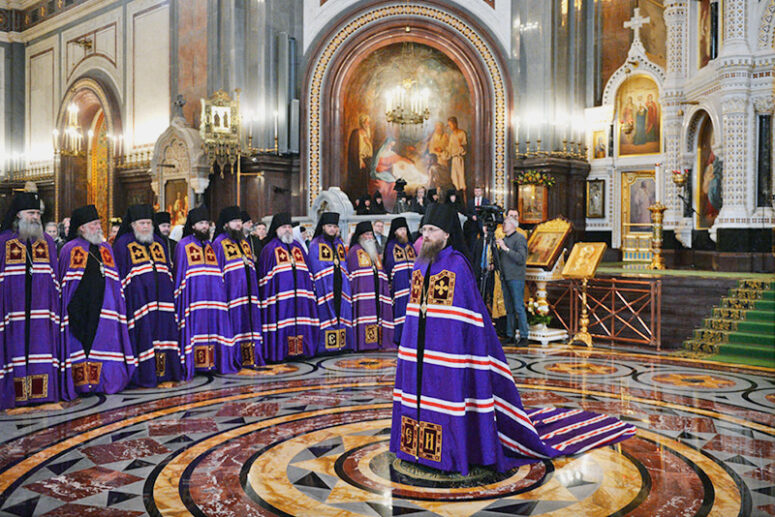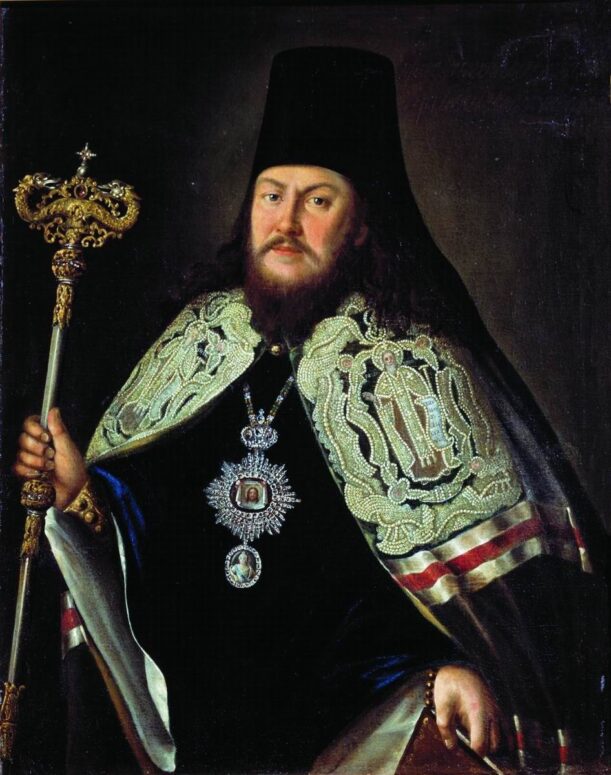
An episcopal mantle is a type of monastic mantle worn by Orthodox patriarchs, metropolitans, archbishops and bishops attending church services or processions. There are some differences in mantles worn by each of the listed clergy members. Clearly, these vestments have been formed and modified over time.
Elements and Symbolism
An episcopal mantle is a long, wide garment, a kind of a sleeveless cloak, fastened at the collar and at the hem and forming a train with its length.
The main elements of an episcopal mantle are called “tablets” (or “pectorals”) and “rivers” (or “streams”).
Tablets are the rectangular plates sewn onto the mantle, two at the top and two at the bottom. The upper tablets are usually embroidered with crosses, seraphim or (less commonly) icons; the lower tablets usually contain the initials of the bishop. These plates symbolize the Old Testament tablets with the Ten Commandments given by God to Moses on Mount Sinai. They remind that the head of the Church is the Lord, and it is His Law that a bishop should be guided by in his deeds.
Streams are the horizontal white-red-and-white ribbons sewn on the mantle in three rows. They symbolize the word of God going out into the entire world (Ezekiel 47:1-12, John 7:38, Revelation 22:1).
In the Russian Orthodox Church, the mantles differ in color depending on the title. Patriarchs use green, metropolitans – pale or dark blue, archbishops or bishops – purple.

Some History
In the days of the ancient Christian Church, a cloak-like mantle was a secular outer garment. Gradually, the Christian worldview endowed it with the symbolism of humility, purity of life and service to God.
Mantles of emperors and nobility were decorated with colored stripes. This is best illustrated by the mosaic in the Church of San Vitale in Ravenna. Emperor Justinian (5-6 centuries) and his dignitaries are depicted wearing mantles with galloons on the upper left side. The mantle of the emperor differs in color and the galloons, made of more expensive fabric.

After the formation of monasticism in the 4th century, mantles became the main attire of hermits, as they were simple and practical for desert life, protecting from the scorching sun in daytime, and giving warmth at night. From that time, mantles began to acquire additional symbolism. In words of Patriarch Germanus, “Its freely flowing lines typify the wings of the Angels; hence it is called ‘the Angelic vestment'”.
From the 4th century bishops began to wear mantles of white wool, symbolizing a shepherd carrying a sheep. This also reminded the bishops about their God-given obligation to take care of the salvation of their flock. Starting from the 8th century, a white mantle became the distinctive garment for metropolitans.
Bishops’ mantles with streams first appeared in Byzantium as an honorary gift from the Emperor of Constantinople to the patriarch. The king sent a mantle with streams and a Panagia to the newly elected patriarch as a sign of his favor.
It is difficult to determine the exact date when tablets appeared on episcopal mantles. It is clear from iconographic sources that it happened in Russia earlier than in Serbia.
A carved reliquary with an image of St John of Novgorod (12th century), made in 1559 after his glorification, depicts the archbishop wearing a mantle with distinct red tablets without images, which matches the inventory of the real mantle of the saint.

At the same time, the 1340 mural painting from the Church of Hodegetria in Peja, Kosovo depicts St Daniel II of Serbia in a patterned mantle with streams, but without tablets.

By the 15th century mantles became an integral part of the episcopal dignity. In 1675, a council was held in Russia, whose decisions provided detailed instructions regarding the mantles’ color and imagery for clergy members, depending on the title. According to these instructions, patriarchal mantles had crosses on their tablets, while metropolitans and bishops had tablets without images. Archimandrites and abbots were supposed to wear simple monastic mantles without tablets.
However, under the established general rules, privileges were allowed as a reward for individual monasteries and individuals. There are many known cases when Russian bishops and abbots were awarded by emperors with mantles that differed from the accepted norms. As a rule, the tablets on an archpastor’s mantle, as well as their imagery and symbolic meaning depended on the Heavenly patron of the monastery or the episcopal see, the historical events associated with it or the holiday on which the mantle was worn.



You can order an episcopal mantle with tablets in our Catalogue




